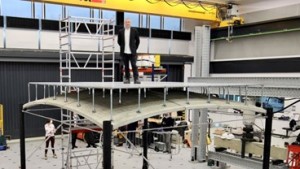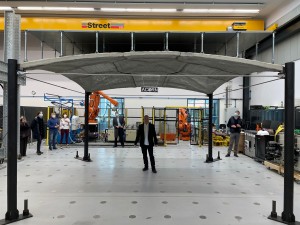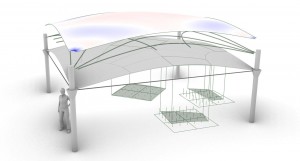The construction industry could massively reduce its use of concrete and slash its carbon footprint by making floors for new buildings in a revolutionary new way, academics at the University of Bath have proved.
They have demonstrated a vaulted style of floor that uses 75% less concrete than a traditional flat slab floor and produces 60% less carbon in its construction.

The academics are part of an interdisciplinary team of structural engineers, mathematicians and manufacturing experts that also includes researchers from the universities of Cambridge and Dundee.
The team recently unveiled a full-scale demonstration of their innovation, with the thin-shell curved structure capable of bearing the same load as one made using traditional methods when covered by standard raised floor panels to create a level surface.
Created by the ACORN (Automating Concrete Construction) research project, which is funded by the UKRI (UK Research and Innovation), the design takes advantage of concrete’s inherent natural properties and strengths and has the potential to significantly reduce the carbon footprint of the built environment.
Dr Paul Shepherd, a reader in Bath’s Department of Architecture & Civil Engineering and the principal investigator for ACORN, pictured standing on, and under, the floor mock-up, said: “Achieving the net zero targets recently ratified at the COP26 conference will require significant change by the construction industry, which is responsible for about half of the UK’s total emissions.

“Since concrete is the world’s most widely consumed material after water, and its production contributes more than 7% of global CO2 emissions, the easiest way for construction to begin its journey to net zero is to use less concrete.
“That has been the driving force behind this project, which we hope could make a major difference to the impact of construction.”
Most building floors currently use thick flat slabs of solid concrete, which are inefficient since they rely on the bending strength of concrete to support loads.
As concrete is not very good at resisting the tension induced by bending, these floors also need lots of steel reinforcement. ACORN’s approach is to make use of concrete’s ability to resist compression.
By putting the material only where it is needed, and making sure it works in compression, the ACORN design uses far less concrete.
The new shape might prove impractical to make using traditional temporary formwork, so the ACORN team has, in parallel, developed an automated adaptable mould and a robotic concrete spraying system that can be used in an off-site factory setting.

Alongside this new style of fabrication, the team has also developed bespoke software to seamlessly optimise floors for a given building design and control the automated manufacturing system to produce them.
As the floor is made off-site, it needs to be transported and then assembled. While this brings some challenges there are also advantages in reducing the time needed on-site for construction.
The ACORN team was also able to incorporate reversible joints, so the floor can be disassembled and reused elsewhere at the end of the building’s life, promoting a circular economy for the construction industry.
Future research is likely to lead to further reductions in carbon as processes are optimised.



















